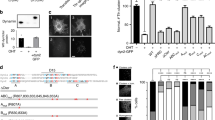Abstract
The GTPase dynamin is a molecular machine that assembles at the neck of clathrin-coated pits and catalyzes the scission of the vesicle neck in a GTPase-dependent fashion [1]. Recent structural work, in combination with biochemical and cell-based experiments, have led to a molecular model of how dynamin functions.
Similar content being viewed by others
Literatur
Daumke O, Praefcke GJK (2016) Invited review: Mechanisms of GTP hydrolysis and conformational transitions in the dynamin superfamily. Biopolymers 105:580–593
Obar RA, Collins CA, Hammarback JA et al. (1990) Molecular cloning of the microtubule-associated mechanochemical enzyme dynamin reveals homology with a new family of GTP-binding proteins. Nature 347:256–261
Takei K, McPherson PS, Schmid SL et al. (1995) Tubular membrane invaginations coated by dynamin rings are induced by GTP-gamma S in nerve terminals. Nature 374:186–190
Hinshaw JE, Schmid SL (1995) Dynamin self-assembles into rings suggesting a mechanism for coated vesicle budding. Nature 374:190–192
Niemann HH, Knetsch ML, Scherer A et al. (2001) Crystal structure of a dynamin GTPase domain in bot h nucleotide-free and GDP-bound forms. EMBO J 20:5813–5821
Chappie JS, Acharya S, Leonard M et al. (2010) G domain dimerization controls dynamin’s assembly-stimulated GTPase activity. Nature 465:435–440
Faelber K, Posor Y, Gao S et al. (2011) Crystal structure of nucleotide-free dynamin. Nature 477:556–560
Ford MG, Jenni S, Nunnari J (2011) The crystal structure of dynamin. Nature 477:561–566
Daumke O, Roux A, Haucke V (2014) BAR domain scaffolds in dynamin-mediated membrane fission. Cell 156:882–892
Gao S, von der Malsburg A, Paeschke S et al. (2010) Structural basis of oligomerization in the stalk region of dynamin-like MxA. Nature 465:502–506
Ramachandran R, Surka M, Chappie JS et al. (2007) The dynamin middle domain is critical for tetramerization and higher-order self-assembly. EMBO J 26:559–566
Reubold TF, Faelber K, Plattner N et al. (2015) Crystal structure of the dynamin tetramer. Nature 525:404–408
Kenniston JA, Lemmon MA (2010) Dynamin GTPase regulation is altered by PH domain mutations found in centronuclear myopathy patients. EMBO J 29:3054–3067
Chin YH, Lee A, Kan HW et al. (2015) Dynamin-2 mutations associated wit h centronuclear myopathy are hypermorphic and lead to T-tubule fragmentation. Hum Mol Genet 24:5542–5554
Chappie JS, Mears JA, Fang S et al. (2011) A pseudoatomic model of the dynamin polymer identifies a hydrolysisdependent powerstroke. Cell 147:209–222
Faelber K, Held M, Gao S et al. (2012) Structural insights into dynamin-mediated membrane fission. Structure 20:1621–1628
Author information
Authors and Affiliations
Corresponding author
Additional information
Oliver Daumke1995–2000 Biologiestudium an den Univer sitäten Freiburg und Köln sowie der University of Sussex, UK. 2001–2004 Doktorarbeit am Max-Planck-Institut in Dortmund und der Universität zu Köln bei Prof. Dr. A. Wittinghofer. 2004–2007 Postdoc am Laboratory of Molecular Biology, Cambridge, UK, bei Prof. Dr. H. McMahon. 2007–2013 Nachwuchsgruppenleiter am Max-Delbrück-Centrum (MDC) in Berlin. Seit 2013 Gruppenleiter am MDC, S-Professor für Strukturbiologie an der FU Berlin.
Katja Fälber1989–1996 Physikstudium (Diplom) an der Universität Mainz und TU Berlin. 1997–2002 Doktorarbeit am Max-Delbrück-Centrum in Berlin bei Prof. Dr. Y. Muller und Prof. Dr. U. Heinemann. 2002–2009 Postdoc an der FU Berlin bei Prof. Dr. W. Saenger und am Leibniz-Forschungsinstitut für Molekulare Pharmakologie bei Prof. Dr. B. Reif. Seit 2009 wissenschaftliche Mitarbeiterin in der Arbeitsgruppe von Prof. Dr. O. Daumke.
Rights and permissions
About this article
Cite this article
Faelber, K., Daumke, O. Struktur und Funktion des mechanochemischen Motorproteins Dynamin. Biospektrum 24, 481–483 (2018). https://doi.org/10.1007/s12268-018-0949-y
Published:
Issue Date:
DOI: https://doi.org/10.1007/s12268-018-0949-y




